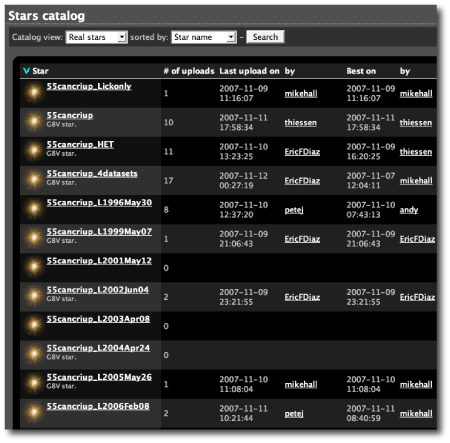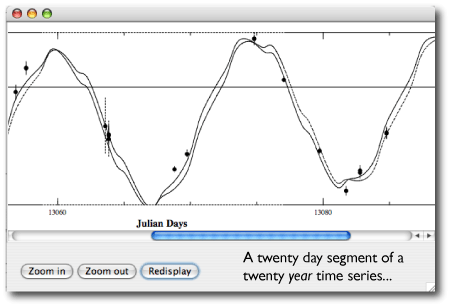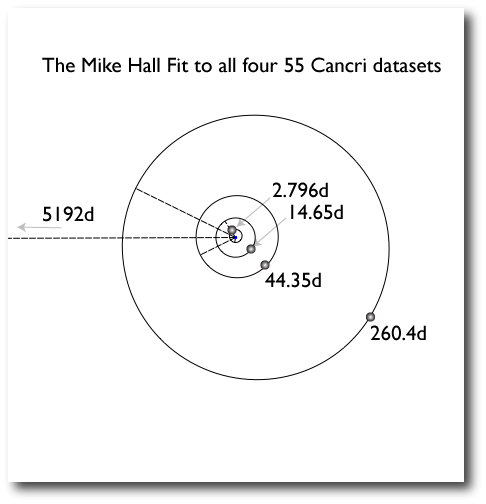
Image Source.
As soon as the new data sets for 55 Cancri from the Keck and Lick Observatories were made public last week, they were added to the downloadable systemic console and to the systemic backend. The newly released radial velocities can be combined with existing published data from both ELODIE and HET.
Just as we’d hoped, the systemic backend users got right down to brass tacks. As anyone who has gone up against 55 Cnc knows, it is the Gangkhar Puensum of radial velocity data sets. There are four telescopes, hundreds of velocities, a nearly twenty year baseline, and a 2.8 day inner periodicity. Keplerian models, furthermore, can’t provide fully definitive fits to the data. Planet-planet gravitational perturbations need to be taken into account to fully resolve the system.
Eugenio has specified a number of different incarnations of the data set. It’s generally thought that fits to partial data sets will be useful for building up to a final definitive fit. Here’s a snapshot of the current situation on the backend:

The “55cancriup_4datasets” aggregate contains all of the published data for all four telescopes. This is therefore the dataset that is most in need of being fully understood. The best fit so far has been provided by Mike Hall, who submitted on Nov. 9th. After I wrote to congratulate him, he replied,
Thanks Greg, […] It actually slipped into place very easily. About 13-30 minutes of adding planets and polishing with simple Keplerian, then 25 iterations overnight with Hermite 4th Order.
The problem is that it seemed like I was getting sucked into a very deep chi^2 minimum, so getting alternative fits may be tricky!
Here’s a detail from his fit which illustrates the degree of difference between the Keplerian and the full dynamical model:

and here’s a thumbnail of the inner configuration of the system. It’s basically a self-consistent version of the best 5-Keplerian fit.

Mike’s fit has a reduced chi-square of 7.72. This would require a Gaussian stellar jitter of 6.53 m/s in order to drop the reduced chi-square to unity. Yet 55 Cancri is an old, inherently quiet star, and so I think it’s possible, even likely, that there is still a considerable improvement to be had. It’s just not clear how to make the breakthrough happen.
This situation is thus what we’ve been hoping for all along with the systemic collaboration: A world-famous star, a high-quality highly complex published data set, a tough unsolved computational problem, and the promise of a fascinating dynamical insight if the problem can be solved.
I’ll end with two comments posted by the frontline crew (Eric Diaz, Mike Hall, Petej, and Chris Thiessen) that I found quite striking. These are part of a very interesting discussion that’s going on right now inside the backend.
When something is this difficult to solve using the ordinary approaches, I start to look to improbable and difficult solutions. In the case of 55C, my hunch is that it’s a system where the integration is necessary, but not sufficient to build a correct solution. I think that the parameter space of solutions is so chaotic that the L-M minimization doesn’t explore it well, or that the inclination of the system is significant enough to skew the planet-to-planet interactions in the console, or both. Trojans or horseshoe orbits would fit these conditions. Perhaps other resonant or eccentric orbits would as well.
I think the high chi square results and flat periodograms after fitting the known planets also point to a 1:1 resonant solution or significant inclination. I just don’t think there’s enough K left to fit another significant planet unless it’s highly interactive with the others.
I’m going to keep working on this system in the hopes that we can find a solution (and because it’s really, really fun), but I suspect that a satisfactory answer won’t be found without a systematic search of the parameter space including inclination.
— Chris
“Nature is not stranger than we imagine but stranger than we can imagine.†Or words to that effect, I can’t remember who said that but in all probability this system shall have more questions answered about it (or not as is often the case!) by direct imaging e.g. such as by the Terrestrial Planet Finder (TPF) mission to show what is really happening (if it is ever launched). The 55 Cancri system is listed as 63 on the top TPF 100 target stars.
In the meantime, we struggle on… I don’t think I can add anything else to what Eric and everyone else has said…
— Petej

Hi Greg,
Very nice summary of the situation. Personally, I think that 55 Cancri should be bumped-up to number 1 on the list of the top 100 target stars of the Terrestial Planet Finder (TPF), that is of course, as Petej pointed out, it ever gets launched.
Best,
Eric
If the integration is important, then the actual values of the masses and not the minimum masses should be used. If I recall, the current version of the console doesn’t do inclinations, so this is a major shortcoming to dynamical fits. Even ignoring mutual inclinations between planets (which are probably small in this system since the eccentricities are also small), it would be interesting to compute the chi-square of the fully-interacting dynamical models at a range of plane-of-sky inclinations (keeping the other parameters fixed, for now). Like Gl 876, it may be that the dynamics is already starting to hint at an inclination of the system.
Hi Darin,
You are quite correct that integration is a necessary, but insufficient requirement for the solution of the datasets for 55 Cancri. A paper was written about a system similar in complexity to 55 Cancri, HD37124. I think my systemic colleague, Mike Hall put it best when he said the following in a message to me: “the chi^2 landscape for HD37124 is like a mandelbrot fractal, the deeper you go, the more detail there is. It’s like a slowly undulating plain with frequent dips and bumps, with maybe the occasional pit.”–the pit of course being a relatively low Chi² value. Well the same holds true for 55 Cancri and all other systems of such a highly dynamic nature. I have worked on Gliese 876, and I can tell you right now that Gl 876 is a walk through the park compared to 55 Cancri.
After reading the paper–which by the way can be found under arxiv 0710.5440v1–I was left with the impression that the chances of finding a proper solution to 55 Cancri with the current datasets using the current incarnation of the console on a PC was slim to none, and that basically every time we do a fit for 55 Cancri it’s a crap-shoot, except the odds are much worse. 55 Cancri is no Gl 876, and it refuses to give up any of its secrets.
Eric
55 Cancri is just plain evil: you even get significant interactions between the 14-day planet and the 5000-day planet in a 2-planet fit.
Another system that seems quite resistant to the console analysis is HD 82943, though since the baseline is not as long in comparison to the orbital periods it is much less evil.
For these systems, synthetic datasets for various system inclinations might be useful, short of allowing the console to handle inclination for integrated fits.
Pingback: Sorting Out Science » Blog Archive » Philosophia Naturalis #15